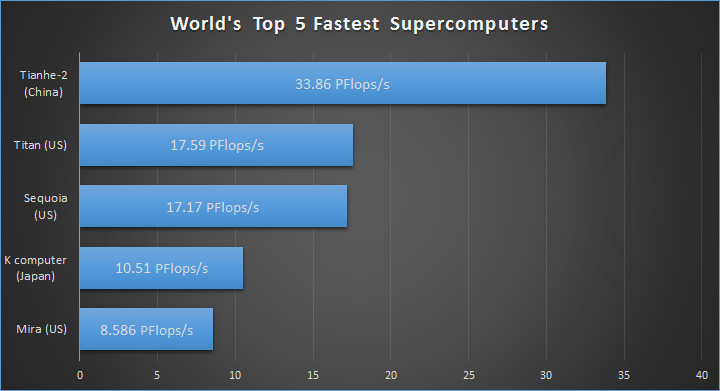
How much processor cores do you have on your computer? most home computers have a 4, 6, 8, or 16 processor cores, and in case of sophisticated servers in data centers it spikes to 128 cores. Can you imagine a computer that has 3 million processor cores? China’s Tianhe-2 also called milky way-2 is at present the world’s fastest supercomputer with exactly 3,120,000 processor cores. The number is really huge isn’t it?
Tianhe-2 vs other top supercomputers

3,120,000 cores Intel Processors and 1.404 petabytes of RAM
There are a total of 125 cabinets housing 16,000 compute nodes, each of which contains two Intel Xeon (Ivy Bridge) CPUs and three 57-core Intel Xeon Phi accelerator cards. Each compute node has a total of 88GB of RAM. There are a total of 3,120,000 Intel cores and 1.404 petabytes of RAM, making Tianhe-2 by far the largest installation of Intel CPUs in the world
33.86 petaflops per second
Tianhe-2 has a performance of 33.86 petaflop/s (quadrillions of calculations per second) on the Linpack benchmark. This is far far better than the No.2 supercomputer, Cray’s Titan Supercomputer which can run calculations at 17.59 petaflops/s
Developed by 1,300 Scientists
It was built by China’s National University of Defense Technology (NUDT) in collaboration with the Chinese IT firm Inspur. Tianhe-2 was developed by a team of 1,300 scientists and it is located in Sun Yat-sen University, Guangzhou.
Runs on Linux
The supercomputer runs on runs on a version of Linux called Kylin, which was natively developed by the NUDT
24 MW of Power
The peak power consumption for the processors, memory, and interconnect is 17.6 megawatts, with the water cooling system bringing that up to 24MW
Applications
Tianhe-2 will be used for simulation, analysis, and government security applications


![15+ Best and Must-Have Software for your New PC [2020] 15-Best-and-Must-Have-Software-for-your-New-PC-2020-Edtion](https://thetechgears.com/wp-content/uploads/2019/12/15-Best-and-Must-Have-Software-for-your-New-PC-2020-Edtion-100x70.jpg)







![15+ Best and Must-Have Software for your New PC [2020] 15-Best-and-Must-Have-Software-for-your-New-PC-2020-Edtion](https://thetechgears.com/wp-content/uploads/2019/12/15-Best-and-Must-Have-Software-for-your-New-PC-2020-Edtion-324x160.jpg)


I like that the “average” home pc can have 16, or even 8 cores.
Thank you, I have just been searching for info approximately this topic for ages and yours is the
best I have discovered so far. But, what concerning the
conclusion? Are you certain in regards to
the source?